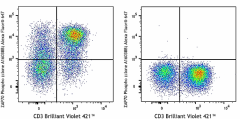- Clone
- A16038B (See other available formats)
- Regulatory Status
- RUO
- Other Names
- p Zeta-Chain (TCR) Associated Protein Kinase 70 kD, p 70 KD Zeta-Chain Associated Protein, p Tyrosine-protein kinase ZAP-70
- Isotype
- Mouse IgG1, κ
- Ave. Rating
- Submit a Review
- Product Citations
- publications

-

Human peripheral blood lymphocytes were treated with (left), or without (right) Hydrogen Peroxide for five minutes, fixed with Fixation Buffer, permeabilized with True-Phos™ Perm Buffer, then surface stained with CD3 Brilliant Violet 421™ and intracellularly stained with anti-ZAP70 Phospho (Tyr292) (clone A16038B) Alexa Fluor® 647.
| Cat # | Size | Price | Quantity Check Availability | Save | ||
|---|---|---|---|---|---|---|
| 693807 | 25 tests | £94 | ||||
| 693808 | 100 tests | £238 | ||||
ZAP70 was identified in TCR-stimulated Jurkat cells. It is an inactive cytosolic tyrosine kinase that is recruited to a transmembrane receptor lacking intrinsic catalytic activity. ZAP70 and the related spleen tyrosine kinase (Syk) play a critical role in T-cell development and activation. This enzyme, which is phosphorylated on tyrosine residues upon T-cell antigen receptor (TCR) stimulation, functions in the initial step of TCR-mediated signal transduction in combination with the Src family kinases, Lck and Fyn.
ZAP70 activation can be regulated by binding to phosphorylated ITAMs of the TCR and by phosphorylation of multiple tyrosine residues on ZAP70. Phosphorylation of Tyr315 and Tyr319 are essential for ZAP70 positive regulation of T-lymphocyte activation whereas Tyr292 has a negative regulatory role.
Mutation of Tyr292 to phenylalanine enhanced NFAT induction in response to BCR stimulation, indicating phosphorylation of Tyr292 may promote association of ZAP-70 with a negative regulatory protein. ZAP-70 has been reported to bind Cbl following TCR stimulation and phosphorylation of Tyr292 was required for this interaction, as well as for the negative effect of Cbl on signaling.
Product Details
- Verified Reactivity
- Human
- Antibody Type
- Monoclonal
- Host Species
- Mouse
- Immunogen
- Human ZAP70 peptide phosphorylated at Tyr292. Complete Freund's adjuvant.
- Formulation
- Phosphate-buffered solution, pH 7.2, containing 0.09% sodium azide and BSA (origin USA)
- Preparation
- The antibody was purified by affinity chromatography and conjugated with Alexa Fluor® 647 under optimal conditions.
- Concentration
- Lot-specific (to obtain lot-specific concentration and expiration, please enter the lot number in our Certificate of Analysis online tool.)
- Storage & Handling
- The antibody solution should be stored undiluted between 2°C and 8°C, and protected from prolonged exposure to light. Do not freeze.
- Application
-
ICFC - Quality tested
- Recommended Usage
-
Each lot of this antibody is quality control tested by immunofluorescent staining with flow cytometric analysis. For flow cytometric staining, the suggested use of this reagent is 5 µl per million cells in 100 µl staining volume or 5 µl per 100 µl of whole blood.
* Alexa Fluor® 647 has a maximum emission of 668 nm when it is excited at 633 nm / 635 nm.
Alexa Fluor® and Pacific Blue™ are trademarks of Life Technologies Corporation.
View full statement regarding label licenses - Excitation Laser
-
Red Laser (633 nm)
- Application Notes
-
During development, reactivity was observed with mouse phospho-SYK.
- Additional Product Notes
-
View more applications data for this product in our Scientific Poster Library.
- RRID
-
AB_2687043 (BioLegend Cat. No. 693807)
AB_2687043 (BioLegend Cat. No. 693808)
Antigen Details
- Structure
- 619 amino acids with a predicted molecular weight of 70 kD.
- Distribution
-
Cytoplasm; Human T Cells, Mouse T cells and B cells.
- Function
- Required for the assembly of a Zap-70-containing signaling complex. Activation of the PLC-γ1-dependent and Ras-dependent signaling cascades. Associates with PLC-γ 1.
- Interaction
- NFAM1, Cbl, SLA and SLA2, CBLB, DEF6, FCRL3, VAV1, CD247/CD3Z.
- Cell Type
- B cells, T cells
- Biology Area
- Cell Biology, Immunology
- Molecular Family
- Phospho-Proteins, Protein Kinases/Phosphatase, TCRs
- Antigen References
-
1. Chan AC, et al. 1991. Proc. Natl. Acad. Sci. USA 88:9166.
2. Arpaia E, et al. 1994. Cell 76:947.
3. Chan AC, et al. 1994. Science 264:1599.
4. Negishi I, et al. 1995. Nature 376:435.
5. Wang H, et al. 2010. Cold Spring Harb. Perspect. Biol. 2:a002279.
6. Klammt C, et al. 2015. Nat. Immunol. 16:961.
7. Weiss A, et al. 1993. Cell 73:209.
8. Gong Q, et al. 2001. J. Exp. Med. 194:507.
9. Magnan A, et al. 2001. J. Exp. Med. 194:491. - Gene ID
- 7535 View all products for this Gene ID
- UniProt
- View information about ZAP70 Phospho Tyr292 on UniProt.org
Related Pages & Pathways
Pages
Related FAQs
Other Formats
View All ZAP70 Phospho (Tyr292) Reagents Request Custom Conjugation| Description | Clone | Applications |
|---|---|---|
| PE anti-ZAP70 Phospho (Tyr292) | A16038B | ICFC |
| Alexa Fluor® 488 anti-ZAP70 Phospho (Tyr292) | A16038B | ICFC |
| Purified anti-ZAP70 Phospho (Tyr292) | A16038B | ICFC,Direct ELISA |
| PerCP/Cyanine5.5 anti-ZAP70 Phospho (Tyr292) | A16038B | ICFC |
| Alexa Fluor® 647 anti-ZAP70 Phospho (Tyr292) | A16038B | ICFC |
| PE/Cyanine7 anti-ZAP70 Phospho (Tyr292) | A16038B | ICFC |
Compare Data Across All Formats
This data display is provided for general comparisons between formats.
Your actual data may vary due to variations in samples, target cells, instruments and their settings, staining conditions, and other factors.
If you need assistance with selecting the best format contact our expert technical support team.
-
PE anti-ZAP70 Phospho (Tyr292)

Human peripheral blood lymphocytes were treated with (left),... -
Alexa Fluor® 488 anti-ZAP70 Phospho (Tyr292)

Human peripheral blood lymphocytes were treated with (left),... -
Purified anti-ZAP70 Phospho (Tyr292)

Human peripheral blood lymphocytes were treated with (left),... -
PerCP/Cyanine5.5 anti-ZAP70 Phospho (Tyr292)

Human peripheral blood lymphocytes were treated with (left),... -
Alexa Fluor® 647 anti-ZAP70 Phospho (Tyr292)

Human peripheral blood lymphocytes were treated with (left),... -
PE/Cyanine7 anti-ZAP70 Phospho (Tyr292)

Human peripheral blood lymphocytes were treated with (left),...
 Login / Register
Login / Register 












Follow Us